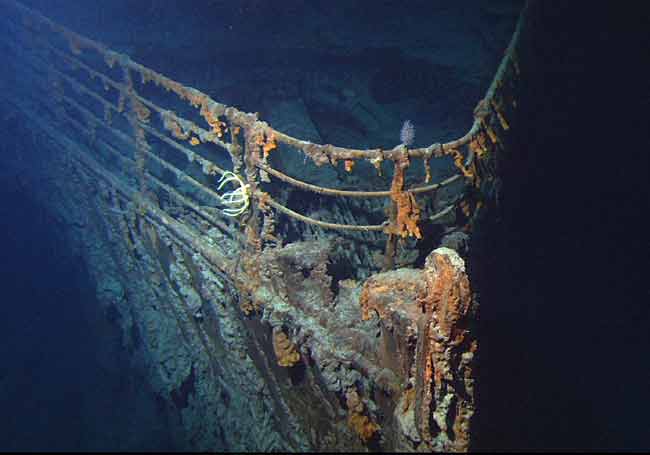Could the Titanic Disaster Happen Today?

A century ago on Sunday, the RMS Titanic hit an iceberg and sank to a watery grave, killing 1,514 passengers. The disaster conjures images of luxury and hubris, cowardice and heroism, as well as one haunting question: Could it happen again?
In many ways, it already has, according to maritime experts. The Northern Maritime Research shipwreck database, for example, lists more than 470,000 shipwrecks in North America in the 20th century alone. Extremely deadly shipwrecks are much more rare, of course, but even the infamous Titanic disaster was only the sixth-deadliest shipwreck in history. The deadliest, the sinking of the German hospital ship the MV Wilhelm Gustloff by Soviet torpedoes, killed more than 9,000 people. That disaster occurred in 1945 — long after the Titanic's wreck in 1912.
Certain facets of the Titanic's sinking are likely not to be repeated. But other risks still remain, said Mahlon "Chuck" Kennicutt II, an oceanographer at Texas A&M University.
"You never can completely eliminate risk," Kennicutt told LiveScience. "It's just a matter of trying to minimize it."
Lessons from the Titanic
In fact, the Titanic disaster taught shipbuilders and crew plenty about minimizing risks. Famously, the ship had too few lifeboats for its passengers, and the evacuation procedure was disastrous.
"There are documented cases of people refusing to get into boats," said Charles Weeks, an emeritus professor of marine transportation at the Maine Maritime Academy, and a member of the Titanic International Society. It wasn't immediately obvious how much danger the Titanic was in, Weeks told LiveScience, so people hesitated to jump into lifeboats being lowered into the frigid North Atlantic.
Sign up for the Live Science daily newsletter now
Get the world’s most fascinating discoveries delivered straight to your inbox.
"The lights were on, the heat was on, so it was warm and comfortable, particularly if they stayed inside," Weeks said. [Stunning Shots of the Titanic Shipwreck]
Lives could have been saved if Titanic officers were more forceful in loading passengers onto boats, said George Behe, a member of the Titanic Historical Society and author of several books on the disaster. Behe credits one man, Fifth Officer Harold Lowe, with saving many lives due to his insistence that passengers board lifeboats. Lowe also rowed back to the wreck site after the ship sank, looking for survivors.
"Having said that, though, Fifth Officer Lowe was also responsible for the deaths of a certain number of well-to-do first-class passengers, since he later boasted to survivor Margaret Brown that he personally saw to it that none of the Titanic's 'rich nabobs' would find a seat in the lifeboats and that those 'nabobs' must take their chances on the ship with 'good men.'" Behe told LiveScience.
Better officer training and sufficient lifeboats would eliminate many of these issues today, Kennicutt said. So, too, would better navigation aids that would have been more likely to prevent the iceberg strike in the first place. Modern communication would have made rescue more likely.
"If another ship mid-ocean had an accident, I would expect a much higher survival rate," Weeks said. "More crew trained to handle lifeboats, sufficient lifeboats, better radio communications."
Shipbuilding technology is certainly better today, Kennicutt said. For instance, though Titanic was built to high standards in her day, 1912 steel contained more impurities than modern steel and was more brittle in the cold.
Perils of the sea
But as Kennicutt stresses, there are always risks to taking to the sea. At any given time, he said, there are an estimated 4 million commercial fishing vessels on the ocean, with tens of thousands more cruise liners, oil tankers, military ships and private vessels beside.
"Because there are so many more ships, there are that many more opportunities for mishaps to occur," Kennicutt said.
Ships are increasingly venturing into Arctic and Antarctic waters that may be poorly mapped and treacherous, Kennicutt added. In December 2011, for example, a Russian fishing vessel hit an iceberg in the Ross Sea of Antarctica and took on water. The vessel was stranded for almost two weeks and risked spilling its fuel into an important emperor penguin feeding ground. Eventually, crew members were able to make enough repairs to get the damaged ship to New Zealand.
Human error plus laxity around safety regulations are often to blame for maritime disasters, Kennicutt said. In one deadly accident in 1987, the passenger ferry Doña Paz collided with an oil tanker. After the collision, a fire spread to the Doña Paz, which was loaded down with perhaps twice as many passengers as it could safely handle. Only 24 people survived the wreck, and the death toll is estimated at more than 4,000.
"If you're operating outside the capabilities of the system, then you've really increased the risk of a bad accident," Kennicutt said.
You can follow LiveScience senior writer Stephanie Pappas on Twitter @sipappas. Follow LiveScience for the latest in science news and discoveries on Twitter @livescience and on Facebook.

Stephanie Pappas is a contributing writer for Live Science, covering topics ranging from geoscience to archaeology to the human brain and behavior. She was previously a senior writer for Live Science but is now a freelancer based in Denver, Colorado, and regularly contributes to Scientific American and The Monitor, the monthly magazine of the American Psychological Association. Stephanie received a bachelor's degree in psychology from the University of South Carolina and a graduate certificate in science communication from the University of California, Santa Cruz.









